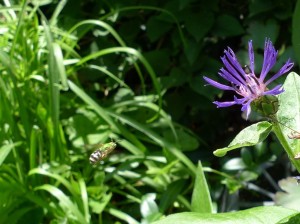It’s Pollinator Week and everyone wants to know what to do for the bees. The one best thing you can do for bees is to plant flowers. The bees will find even little flowers in a windowbox or a small container. But what kind of flowers?
Ideally for native bees you want to give priority to flowers native in your region. All bees prefer old-fashioned single varieties of flowers. Some modern ornamentals have had the pollen bred out of them. Doubled flowers don’t have any room in the center for bees. Bees generally prefer blue, purple, white, or yellow flowers. Whatever you plant, aim for a variety of flowers so that something is blooming throughout the year. And always looks for plants and seeds that are organic and/or untreated with systemic, persistant pesticides.
This list is by no means complete. Nor do I confine it to native plants. (That’s another issue.)
My Bee All-Stars: These are plants that make me happy watching all the bees. Some are wildflowers you might call “weeds”. This group is roughly in order of flowering.
Crocus, Grape Hyacinth (Muscari), Mountain Bluet (Centaurea), Borage, Raspberries, Nepeta “Walker’s Low”, Salvia, Blanket Flower (Gaillarda) , Butterfly Bush (Buddleia), Oxeye Sunflower (Heliopsis Helianthoides), Anise Hyssop (Agastache), Sunflowers, Purple coneflowers (Echinaecea), Joe Pye weed, New England Aster, Goldenrod, Sedum “Autumn Joy”. For the wildflowers add: Bladder Campion, Daisy Fleabane, St. John’s Wort, Hawkweed, Wild Aster.
And other sources recommend many more flowering plants that can be grown in the Boston area.
Bulbs and early spring flowers: Bulbs help feed the first bees of spring, such as honeybees on warm days, Bumblebee queens, and Early Miner Bees
Crocus, Snowdrops, Siberian Squill. Bleeding Heart (Dicentra). Dandelions and clover.
Herbs: Just about any herb draws lots of little bees and other beneficial insects once they flower. The beneficial insects give you an extra bonus of pest control.
Mints, Catnip, Basil, Sage, Thyme, Oregano, Lavender, Chives, Verbena, Marjoram, Cilantro/Coriander, Dill.
Berries: Berries feed a variety of native bees — and you!
Strawberries, Blueberries, Raspberries, Blackberries, Serviceberry, Bearberry (Arctostaphylos uva-ursi ), Common Hackberry (Celtis occidentalis ), Elderberry (Sambucus )
Fruiting vegetables: Some bees have specialized skills for families of vegetables. Squash Bees only pollinate cucurbits. Bumblebees can shake the flowers of nightshades to buzz-pollinate them, and are strong enough to climb into the flowers of legumes.
Cucurbits: Cucumbers, Summer Squash, Winter Squash, Pumpkins, Melons, Watermelons; Nightshades: Tomatoes, Peppers, Eggplant; Legumes: Peas, Beans.
Leafy vegetables: If your greens start to bolt in the heat, let some flower. The four-petalled yellow flowers of crucifers will make the bees happy.
Broccoli, Radishes, Turnips, Collards, Bok Choy, Chinese Broccoli.
Annual flowers: Usually have a long flowering season, which helps feed bees all summer. Look for heirloom varieties with single flowers. Organic and untreated seeds and starts are widely available.
Cosmos, Bachelor buttons, Lobelia, Zinnias, Cleome, Fuschia, Heliotrope, Lantana, Tithonia, Morning Glories, Sunflowers, Sweet Alyssum, Snapdragons.
Perennial flowers: Often flower only for a short time, but give generously to bees when they do. Organic and untreated live plants are hard to find. Organic and untreated seed are widely available.
New England Asters, Black-Eyed Susans, Gaillardia, Cup Plants, Goldenrod, Purple Loosestrife, Centaurea, Bee Balm, Shasta Daisy, Common Milkweed (Asclepias syriaca), Butterfly Weed (A. tuberosa), Swamp Milkweed (A. incarnata ), Salvia, Phlox, Lupine, Meadowsweet, Sneezeweed (Helenium), Spiderwort (Tradescantia), Turtlehead, Wild indigo (Baptisia), Violets (Viola), Cranesbill (Geranium), Columbines (Aquilegia), Black Cohosh (Actea racemosa), Blazing Star (Liatris spicata).
Shrubs: A good-sized shrub in flower can buzz with bees. Organic and untreated live shrubs are hard to find.
Lilac, Azalea, Spirea, Virginia Sweetspire (Itea Virginica), Beauty Bush, Butterfly Bush (Buddleia), Wisteria, Honeysuckle, Sweet Autumn Clematis, Old-fashioned single Roses, Hydrangea, Azalea, Hawthorn, New Jersey tea (Ceanothus), Sourwood (Oxydendrum arboreum), Buttonbush (Cephalanthus occidentalis ), Dwarf Sumac (Rhus copallium).
Trees: Trees can be an important source of pollen for bees in the spring. Sadly, some flowering varieties have been bred not to shed pollen. Organic and untreated trees are hard to find.
Fruit trees such as Pears, Apple, Peaches, Plums, Cherries; Willow, Maple, Black Locust, Sumac, Basswood, Sassafras, Eastern Redbud (Cercis canadensis ).
That should be enough to get you started!
Sources:
A cool chart of wildflowers for bees from New England Wildflower Society.
Plant list for honeybees from Anita Deeley a beekeeper in Beverly, MA.
Article about planting for bees in Mar/Apr issue of Green News from Green Decade Newton by Anna Zeusler.
Northeast Plants for Native Bees PDF on Xerces.org
Eastern Broadleaf Oceanic – Guide page on Pollinator Partnership
Just for fun, I’m also collecting bee plant lists on Pinterest.



